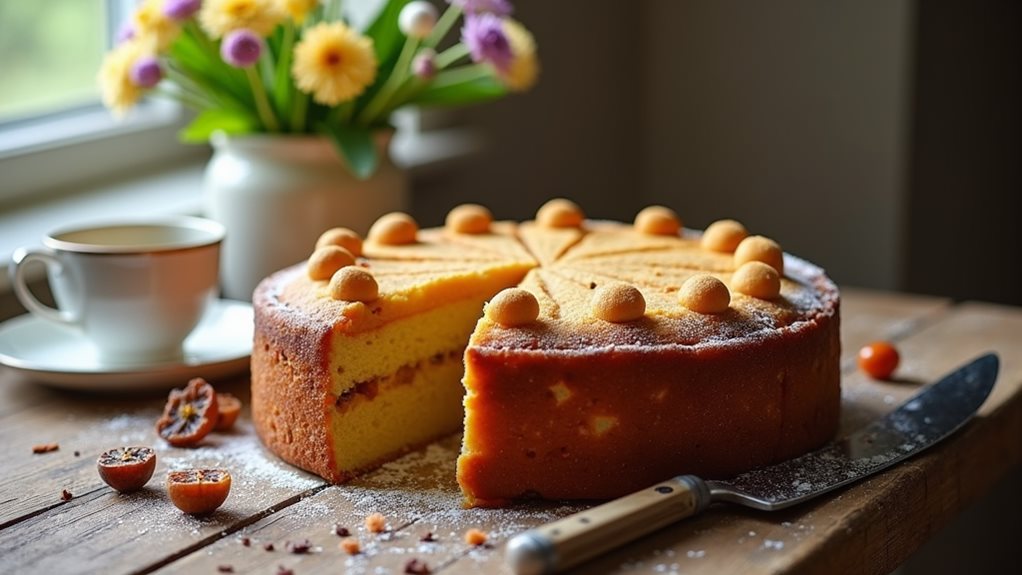You'll discover that Simnel Cake carries more significance than just being another fruit cake on your Easter table. While its medieval origins trace back to servant girls honoring their mothers, this layered masterpiece has evolved into a symbolic treat that tells a story through its distinctive decorations. The eleven marzipan balls crowning its top aren't mere embellishments, and the hidden almond layer waiting to surprise you isn't just about taste. As you explore this traditional British creation, you'll understand why generations have cherished this special cake and continue passing down its legacy.
Key Takeaways
- A Simnel Cake is a traditional Easter fruit cake with marzipan layers inside and eleven marzipan balls on top.
- Basic ingredients include fruit cake mix, dried fruits, butter, sugar, eggs, spices, and 1½ pounds of marzipan.
- Bake at 350°F for about 2 hours and 15 minutes, checking doneness with a skewer after 2 hours.
- Let ingredients reach room temperature before mixing, and pre-soak dried fruits for better moisture and flavor.
- Store in an airtight container for up to two weeks, with flavors improving over time, especially with brandy added.
History
Simnel cake's origins date back to medieval England, where it emerged as a Mothering Sunday tradition. You'll find that servant girls would bake these distinctive fruit cakes to take home to their mothers when they'd visit during the fourth Sunday of Lent, marking a brief respite from their domestic duties.
The cake's name likely derives from the Latin word 'simila,' meaning fine wheat flour, though some believe it's connected to a sister duo, Nell and Sim, who allegedly created the recipe.
You'll notice that traditional Simnel cakes feature eleven marzipan balls on top, representing Jesus's faithful apostles (excluding Judas). In the 17th and 18th centuries, you'd have found these cakes becoming increasingly elaborate, with bakers adding dried fruits, spices, and the signature layer of marzipan both inside and on top of the cake.
During Victorian times, you would've seen Simnel cake's association shift from Mothering Sunday to Easter celebrations, where it remains a beloved tradition today.
The cake's distinct appearance and rich symbolism have helped it maintain its cultural significance in British culinary heritage.
Recipe
Traditional Simnel cake is a light fruit cake with layers of marzipan that's been enjoyed in British households for centuries, particularly during Easter celebrations. The cake is distinguished by its unique decoration of eleven marzipan balls on top, representing the eleven faithful apostles of Jesus.
This rich and flavorful cake combines dried fruits, warm spices, and the sweet almond flavor of marzipan into a celebratory dessert that's both impressive and delicious. The addition of a middle layer of marzipan creates a wonderful surprise when the cake is sliced, adding extra texture and sweetness to each bite.
- 1¾ cups (225g) all-purpose flour
- 1½ cups (350g) mixed dried fruits
- 1 cup (225g) butter, softened
- 1 cup (225g) light brown sugar
- 4 large eggs
- 2 tablespoons milk
- 1½ lbs (675g) marzipan
- 2 teaspoons mixed spice
- 1 teaspoon ground cinnamon
- ¼ teaspoon nutmeg
- Zest of 1 lemon
- 2 tablespoons apricot jam
- 1 egg white (for brushing)
Preheat oven to 300°F (150°C). Cream butter and sugar until light and fluffy, then beat in eggs one at a time. Fold in flour and spices, followed by dried fruits and lemon zest. Pour half the mixture into a lined 8-inch cake tin. Roll out one-third of the marzipan into a circle and place on top of the mixture. Add remaining cake mixture and bake for 2½ hours.
Once cooled, brush top with warmed apricot jam, add rolled marzipan layer, and decorate with 11 marzipan balls. Brown under the broiler briefly.
For best results, make this cake at least a week before serving to allow flavors to develop. Store in an airtight container in a cool place.
When rolling marzipan, dust the surface with powdered sugar rather than flour to prevent sticking. The cake can be made up to three months in advance if stored properly, making it perfect for advance holiday preparation.
Cooking Steps
You'll start by thoroughly greasing your cake pan to ensure easy removal after baking.
Then mix your prepared fruits into the batter until they're evenly distributed throughout.
Next, pour half of your batter into the pan, carefully place your prepared marzipan layer in the center, and add the remaining batter on top before baking at 350 degrees.
Finally, you'll need to monitor the cake's progress, as the rich fruit content requires precise timing to achieve the perfect golden-brown finish while maintaining a moist interior.
Step 1. Grease Cake Pan Thoroughly
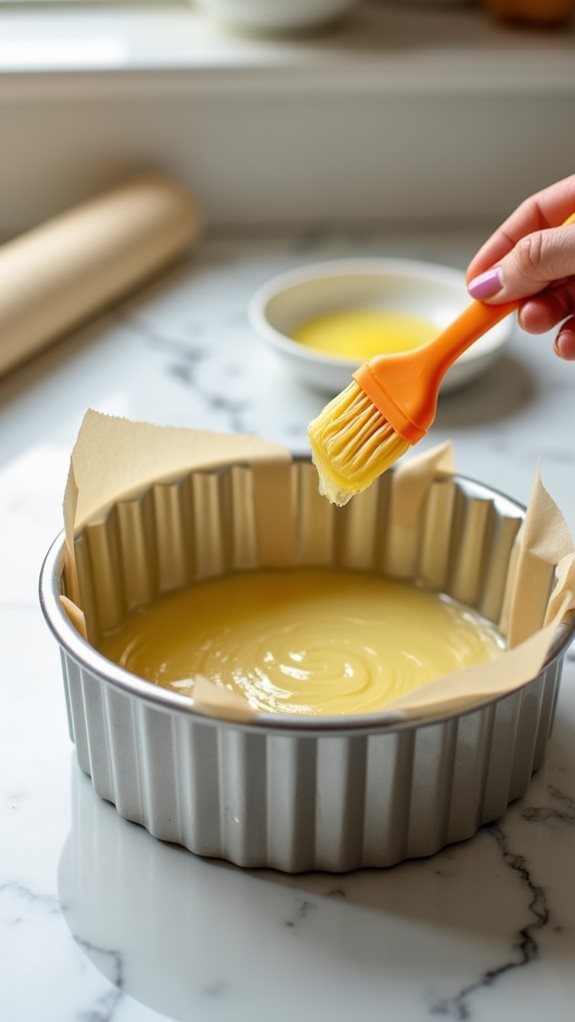
Properly greasing the cake pan is a crucial first step that prevents the Simnel cake from sticking during baking.
You'll want to start with a clean, dry 8-inch round cake pan, making sure there's no residue from previous use that could interfere with the greasing process. Using softened butter or a neutral-flavored cooking spray, thoroughly coat the bottom and sides of the pan, paying special attention to the corners where cake batter often sticks.
For added insurance against sticking, you'll need to line the pan with parchment paper after greasing. Cut a circle of parchment to fit the pan's bottom, and press it firmly into place.
Don't forget to grease the top of the parchment paper as well. For the sides, cut a strip of parchment that's slightly taller than your pan's height, and line the circumference. The extra height will help you remove the cake more easily once it's baked.
If you're using a springform pan, you'll still need to follow these steps, as Simnel cake's dense texture requires extra precaution against sticking.
Step 2. Mix Fruit Into Batter

With your prepared pan ready, it's time to incorporate the signature fruit mixture into your Simnel cake batter. Take your pre-soaked dried fruits, which should include raisins, currants, and candied citrus peel, and drain any excess liquid.
You'll want to ensure the fruits aren't too wet, as this could affect the cake's texture. Gently fold the fruit mixture into your base batter using a large spatula or wooden spoon, making sure you're distributing the fruits evenly throughout.
Don't overmix, as this can lead to a tough cake – instead, use broad, sweeping motions from the bottom of the bowl upward. You'll notice the batter becoming studded with the colorful fruits, creating that classic Simnel cake appearance.
If you're using any whole cherries, you'll want to quarter them first to prevent them from sinking to the bottom of the cake. Once you've achieved an even distribution of fruit throughout the batter, check that there aren't any large pockets of fruit clustering together.
The final mixture should look substantial but still maintain its ability to drop easily from your spoon.
Step 3. Pour Batter Into Pan
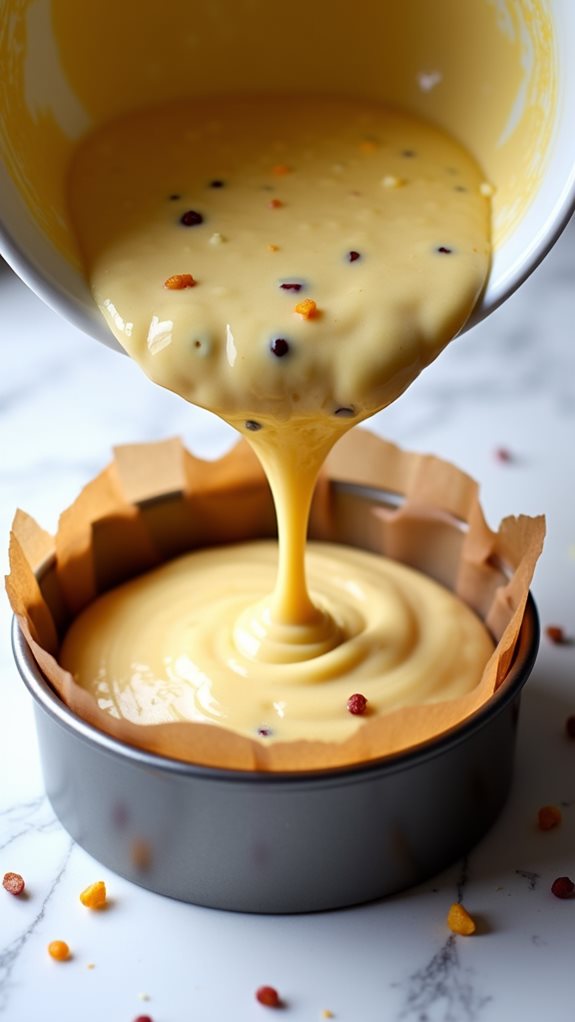
Now that your fruit-laden batter is ready, transfer it carefully into your prepared cake tin, making sure to scrape down the sides of the mixing bowl.
Use a rubber spatula to ensure you don't waste any of the precious mixture, as every bit contributes to your cake's final texture and density.
Level the surface of the batter with the back of your spatula, creating an even top that'll bake uniformly.
Don't forget to gently tap the filled tin on your countertop three or four times to release any trapped air bubbles, which could create unwanted holes in your finished cake.
If you notice the batter's slightly uneven, give the tin a gentle shake to help it settle naturally.
Before placing the tin in the oven, check that you've distributed the batter evenly between the two marzipan layers.
You'll want approximately equal amounts above and below the center layer to ensure proper baking.
The batter should fill the tin to about two-thirds of its height, leaving enough room for the cake to rise during baking without overflowing.
Step 4. Place Marzipan Layer Inside
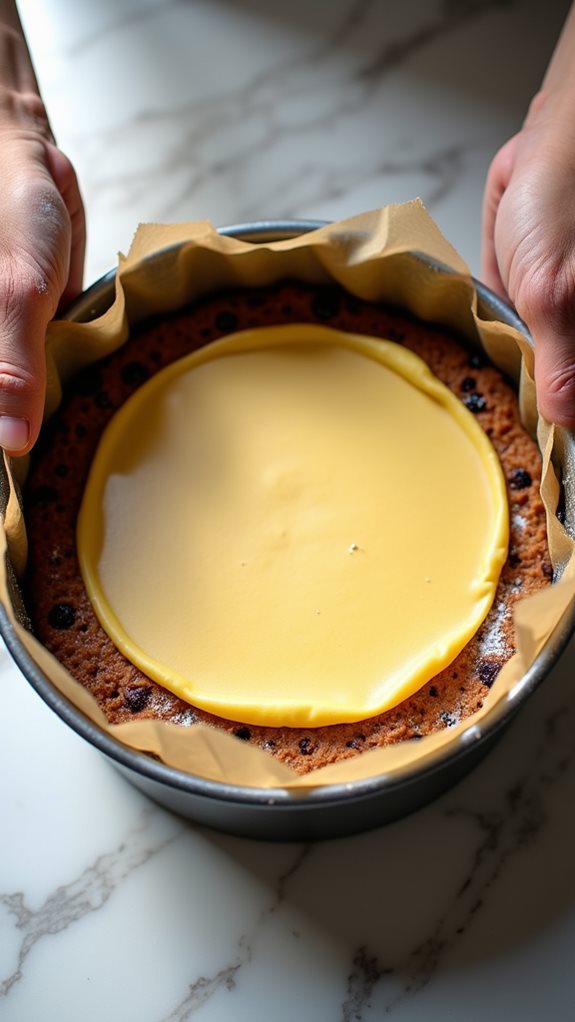
The signature marzipan layer forms the heart of your Simnel cake. After you've poured half of your fruit cake batter into the prepared tin, it's time to add this crucial element.
Roll out one-third of your marzipan into a circle that's slightly smaller than your cake tin's diameter, aiming for about 7 inches across and 1/4 inch thickness.
Carefully lift this marzipan disc and place it gently on top of your first layer of cake batter, making sure it doesn't touch the sides of the tin. You'll want to leave about a 1/2-inch gap around the edge to allow for the cake's expansion during baking.
If you're finding the marzipan's sticking to your work surface, dust it lightly with confectioner's sugar before lifting. Once you've positioned the marzipan layer, spoon the remaining cake batter over it, ensuring you don't disturb its placement.
Take care to spread the batter evenly, covering the entire marzipan disc completely. This hidden layer will create that distinctive sweet almond surprise that's characteristic of a traditional Simnel cake.
Step 5. Bake at 350 Degrees
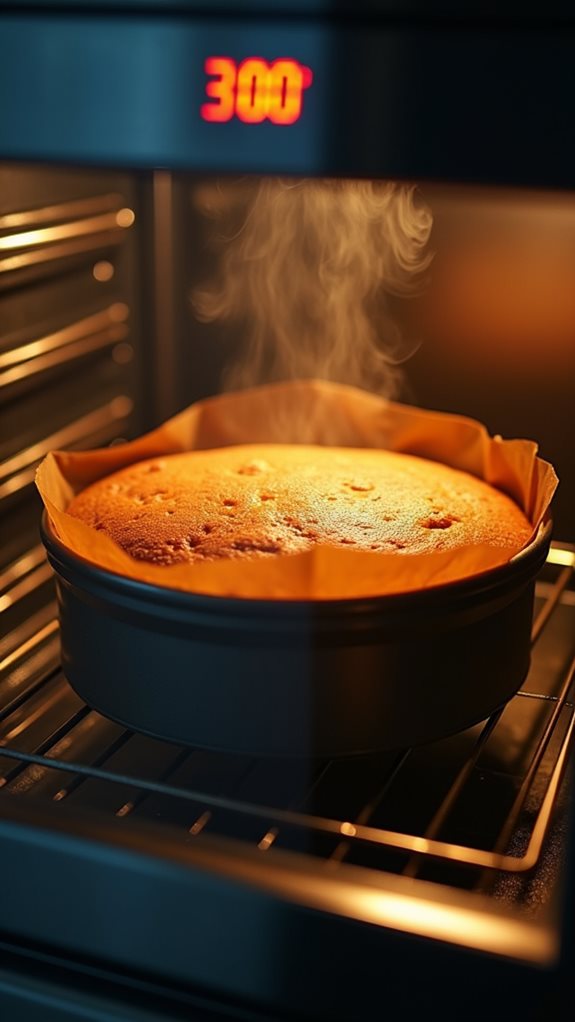
Successful baking of your Simnel cake requires precise temperature control and timing. Preheat your oven to 350°F (175°C), ensuring it's reached the full temperature before you begin.
You'll want to position the cake on the middle rack, where heat distribution is most even. Your cake will need approximately 2 hours and 15 minutes of baking time, but don't rely solely on the clock. Insert a skewer into the center at the 2-hour mark – it should come out clean with no raw batter clinging to it.
The cake's surface should be golden brown, and you'll notice a slight spring-back when you gently press the top. If it's not quite ready, continue baking in 10-minute intervals until done.
Don't open the oven door during the first 90 minutes of baking, as this can cause your cake to sink in the middle. Once it's fully baked, let it cool in the tin for 15 minutes before transferring to a wire rack.
You'll know it's properly baked when the edges have slightly pulled away from the tin's sides.
Final Thoughts
Creating this traditional Easter Simnel cake may seem daunting at first, but you'll find it's well worth the effort. The combination of rich fruit cake, delicate marzipan layers, and the symbolic decorations makes this dessert a true centerpiece for your Easter celebration.
You'll know you've achieved success when your cake has a golden-brown exterior, and the marzipan balls on top have taken on a lovely caramelized color. When you slice into it, you should see a clearly defined marzipan layer running through the center, while the fruit should be evenly distributed throughout the cake.
Don't worry if your decorative work isn't perfect – the charm of homemade Simnel cakes often lies in their handcrafted appearance.
Remember to store your Simnel cake in an airtight container at room temperature, where it'll keep well for up to two weeks. If you've used traditional brandy in the recipe, you'll find the flavors continue to develop and mature over time.
You can also freeze portions of the cake for up to three months, though the marzipan's texture may slightly change upon thawing.

